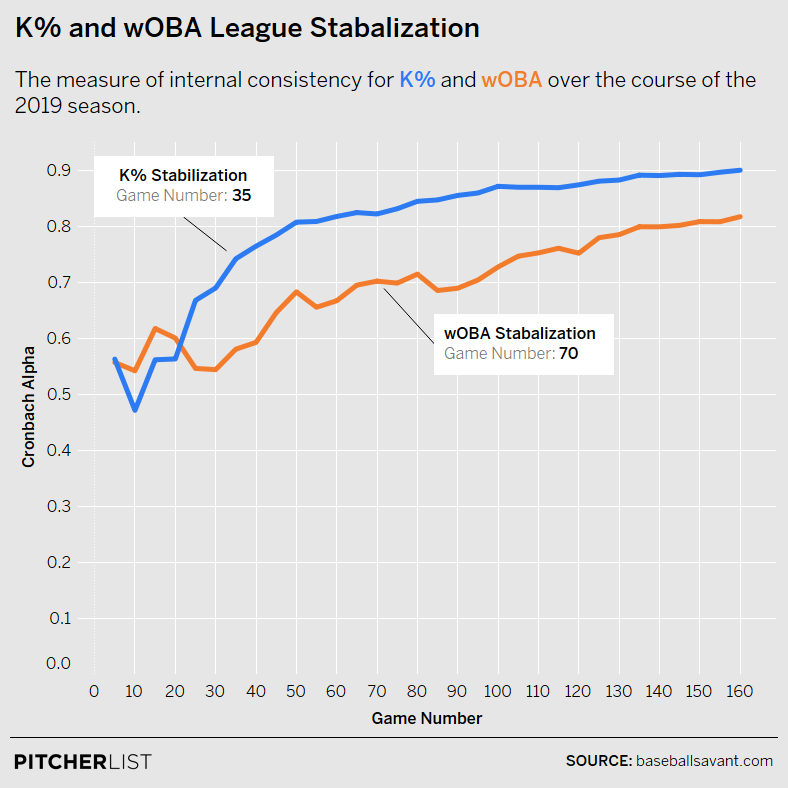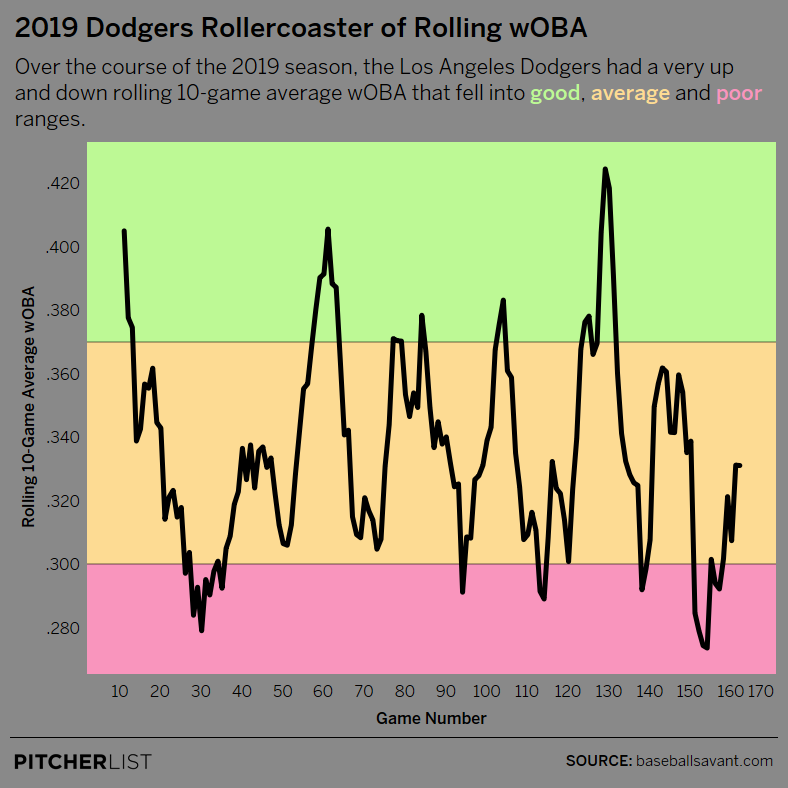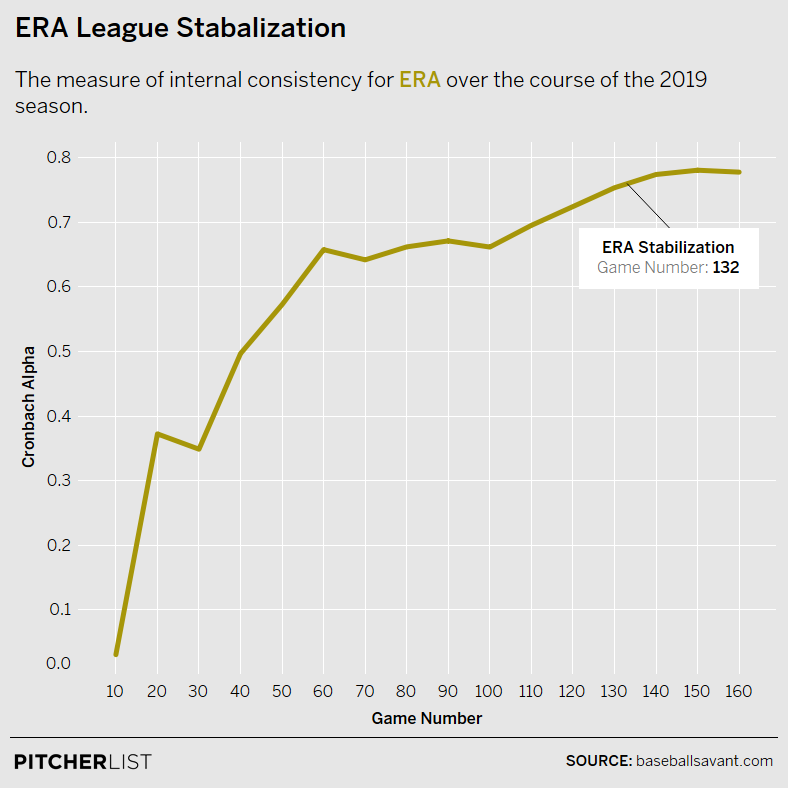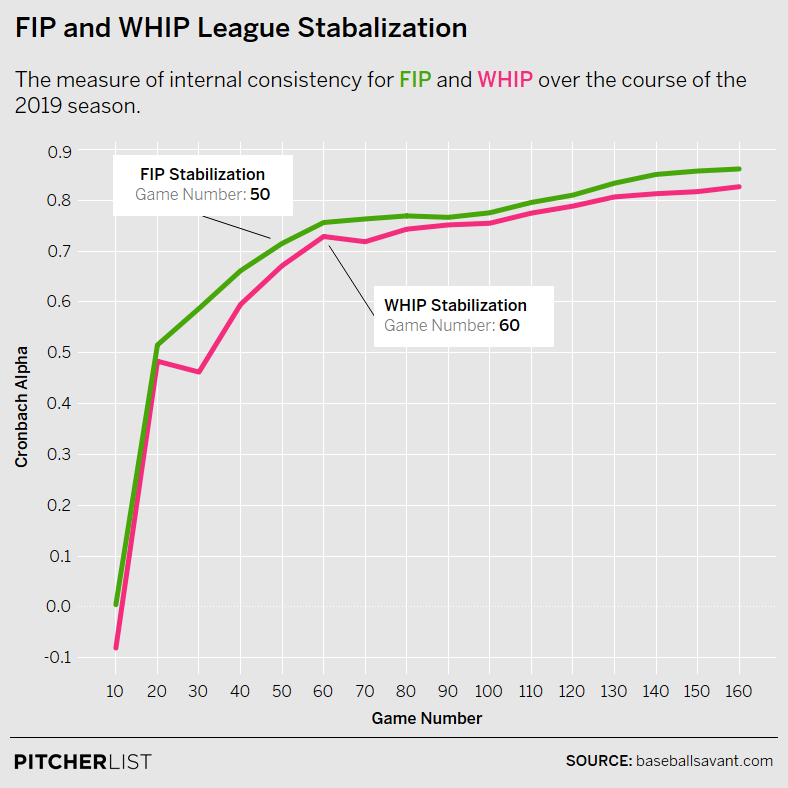Streaming pitchers is one of the most popular strategies fantasy baseball players use throughout the season. It’s all over fantasy baseball sites, in fact, you’d be hard-pressed to find a fantasy baseball site that doesn’t offer you advice on which pitchers to stream (we do it here on Pitcher List). Shoot, there’s even an entire site whose brand is specifically built around streaming starting pitchers.
And as many fantasy baseball players will tell you, streaming pitchers is hard, unpredictable, but also pretty fun when you happen to snag the right guy and he turns in a killer outing for your team.
But how do you know which pitchers to stream? The simple advice is, you find a pitcher going up against a bad offense and stream them (unless they’re an especially bad pitcher), and that’s basically it.
Where things get tricky is when you try to figure out who the “bad offenses” are. Eventually you get an idea, but when is “eventually?” At what point in the season can you start streaming pitchers and feel relatively safe (and I emphasize that streaming pitchers is never truly safe) about the matchup.
As I write this, we are just around 20 games into the season, and here are your top 10 teams in MLB in wOBA:
- Red Sox
- Reds
- Dodgers
- Angels
- Twins
- Atlanta
- White Sox
- Athletics
- Rays
- Royals
Some of those, like the Dodgers and Atlanta, aren’t necessarily a surprise. Others, like the Reds and Royals, are a bit more surprising. And had I offered you this list two weeks ago, the top 10 would’ve included the Mets.
Obviously, we’re looking at an extremely small sample size, and that’s the question I want to answer—when does this sample size stop being small? When do we have a pretty good idea who the good and bad offenses are in the league?
It Was My Understanding There Would Be No Math
In order to figure out when certain key stats stabilize during the season, we need to do some math. Specifically, we need Cronbach’s alpha.
Please don’t fall asleep.
Cronbach’s alpha, also known as tau-equivalent reliability, essentially tells us how closely related a set of items are as a group. In our case, we’re going to be looking at the ratio of an observed stat and the true talent of a team. The closer the alpha is to one, the more reliable the observed stat becomes, and that happens as the sample size grows.
Before we go much further, I want to give quick credit to Justin Filteau, a member of our data science team, for coming up with this idea. This was not me. Our data science team is a godsend, I am just here to write pretty words (and even that’s debatable) about the complicated math done by people significantly smarter than me.
Justin referenced the brilliant work done back in 2015 by Jonah Pernstein and Sean Dolinar on Fangraphs regarding not just Cronbach alpha, but also reliability and confidence bands that tell us how quickly the alpha approaches one.
Essentially, this will tell us at what point in the season certain stats stabilize.
When Do Offensive Stats Stabilize?
For our purposes, we’re going to look at how many plate appearances it takes for a team’s wOBA and strikeout rate to stabilize, and then, once wOBA stabilizes, we’ll figure out how to determine who the good/bad/average teams are for your streaming purposes.
Here’s a look at when the rate of the Cronbach alpha gets closer to one for team wOBA and strikeout rate as plate appearances increased in 2019 (we used 2019 for the obvious reason of, it gives us more plate appearances to work with than 2020 did).

The alpha value first hits 0.7 (which is typically what you would consider a good value) at 70 games for wOBA and at 35 games for strikeout rate. In other words, team wOBA and walk rate stabilize starting around mid-June and strikeout rate stabilizes around early May.
So What Does This Mean?
It means that streaming pitchers is especially risky and unpredictable for essentially the first two months of the season. We may have an idea of who the “good” and “bad” teams are (I mean, we all knew the Pirates and Orioles would be bad before this year’s season even started), but wOBA doesn’t stabilize and become reliable for a while.
If you’ve been playing fantasy baseball for a while and have tried your hand at streaming pitchers, you’ll know it’s often a high-risk/high reward proposition. You could grab a couple of sneaky starts off the waiver wire to bolster your pitching squad for the week, or you could absolutely blow things up because you thought Nick Margevicius was a lock for six solid innings against the Pirates and he gave up six runs in one inning.
A lot of the time, playing fantasy baseball is about taking those risks. Personally, I like to try and be as risk-averse as I can, because so much of fantasy baseball already relies on luck that I’d like to control what can be, at least somewhat, controlled, which is why I would personally avoid streaming pitchers too much until about that 70-game mark.
However, you’ll notice that while wOBA doesn’t stabilize until about 70 games into the season, strikeout rate stabilizes much faster, and that could do two things for us: First, it could give us an early idea of the bad offenses if you need to stream early in the season. It’s important to note that, just because a team strikes out a lot doesn’t mean they’re a bad offense, but generally bad offenses strike out a lot, which is why it could be a useful bellwether for a bad offense.
And second, even if you don’t know what offenses are bad, you will know which offenses are likely to strike out a lot, and that means if, at bare minimum, you’re in a head-to-head league needing some strikeouts and are willing to take a risk on your ERA, you’ll have a pretty good idea of which teams to stream pitchers against.
How Do You Know Which Teams to Stream Against?
So we’re in June, you’ve decided it’s about time to start streaming pitchers, you feel like it’s safe, so how do you know which teams to stream against?
If you’re me, the gut reaction is to say, “Easy. Hop on the leaderboards, sort by team wOBA, go to the bottom, and stream against those teams.”
And generally, that’s probably a fine strategy, but how do you know when a team is actually bad and when they’re just on a cold streak? Or conversely, how do you know when a team is actually good and when they’re on a hot streak?
The best way to do that, we’ve found, is to use a mix of a team’s cumulative wOBA and their rolling wOBA.
As we previously mentioned, a team’s cumulative wOBA stabilizes during the season around the 70-game mark, so we already have that as a starting point.
But cumulative wOBA isn’t everything, and it can be somewhat deceptive. In 2019 at their 115th game, the Los Angeles Dodgers had a cumulative wOBA of .336, which was good for fifth-best in all of baseball. So, naturally, if you were streaming pitchers at that time, you would probably avoid the Dodgers.
However, had you looked at their 10-game rolling wOBA, you would’ve seen something different. Take a look at what that looked like all year—we’ve divided the graph into three sections of what we consider a poor, average, and good team wOBA:

At the 115th game, the Dodgers’ 10-game rolling wOBA was pretty poor, at its lowest point of the season. Why? Because they were on a cold streak.
So to sum it all up, you can use cumulative wOBA as a means of generally figuring out the good, mediocre, and bad offenses for your streaming purposes. But if you need a tiebreaker, take a look at a team’s rolling wOBA to get an idea of who might be on a cold or hot streak.
Can We Use This Strategy For Streaming Hitters?
I know the title of this article is about streaming pitchers, but you’re looking (figuratively) at the guy who has been writing a streaming hitters article every week on this site for the past three years, so naturally, I’m also thinking about how we can stream hitters.
My first instinct with an approach for streaming hitters was to figure out when a team’s ERA stabilizes during the season. Unfortunately, that didn’t work:

Team ERA doesn’t stabilize until around game 132, which is the math’s way of saying “lol yea, good luck.”
But! If we look at FIP and WHIP instead of ERA, we see things stabilize a lot quicker.

FIP stabilizes around 50 games into the season while WHIP stabilizes around 60 games in. So if you go by FIP or WHIP around 60 games into the season, you’ll have a much more predictable idea of which pitching staffs are good and bad.
Let’s Wrap This Up
We’ve gone over a lot of math with a lot of graphs and if it’s all a little overwhelming, I completely understand (because it was certainly a bit overwhelming to me at first).
Basically, here’s the TL;DR version of this article:
If you’re streaming pitchers:
- It’s pretty risky up until around the 70-game mark (even after that, it’s still a bit risky, but less so)
- Use cumulative wOBA to figure out which offenses are tough and which are bad
- Use rolling wOBA to break any ties and figure out if a team you want to stream a pitcher against is on a cold or hot streak
If you’re streaming hitters:
Just kidding (or am I?)
For real though, if you’re streaming hitters, it’s fairly simple—use a team’s FIP and WHIP around the 60-game mark to figure out which teams are worth taking advantage of. And, of course, pay attention to individual pitchers, because we all know there are aces on teams that have otherwise terrible pitching staffs.
Streaming pitchers (and hitters) is a very viable strategy to use for your fantasy league, and while it can be a bit risky, I’m hoping this article offers you some strategies that will make it slightly less risky for you, and ultimately, help you win your fantasy baseball league (because obviously that’s what this site exists for).
Photo by Mark Alberti/Icon Sportswire | Adapted by Justin Paradis (@JustParaDesigns on Twitter)


Bookmarked this one as a reference. Thanks!
Nice article. Where is a good source to find cumulative WOBA and rolling WOBA?
Cumulative wOBA is pretty quick and easy to find on Fangraphs’ team leaderboards. Rolling wOBA is a little bit trickier but you can find it on Baseball Savant. I can give you a more detailed answer on finding rolling wOBA a bit later!
you can look at last 7 days WOBA on fangraphs as well. give you an idea before you pick up a pitcher to stream how the team he is facing has been doing the past 7 days. But still its not guarantee. I stream Cobb tonight against HOU and hmm did not go well. Live by the stream, die by the stream.
Yep! So if you do Fangraphs team stats leaderboards and change the date to the past 10 games, that’ll give you a rolling 10-game average of each team’s wOBA
Just a quick question, are you offended by the Braves? Every other team is their respective mascot except Atlanta. Not saying its right or wrong, just odd.
As a site, Pitcher List generally tries to avoid using the team mascot names for Atlanta and Cleveland
As someone that lives in Atlanta and loves my team, I have no problem with this whatsoever.